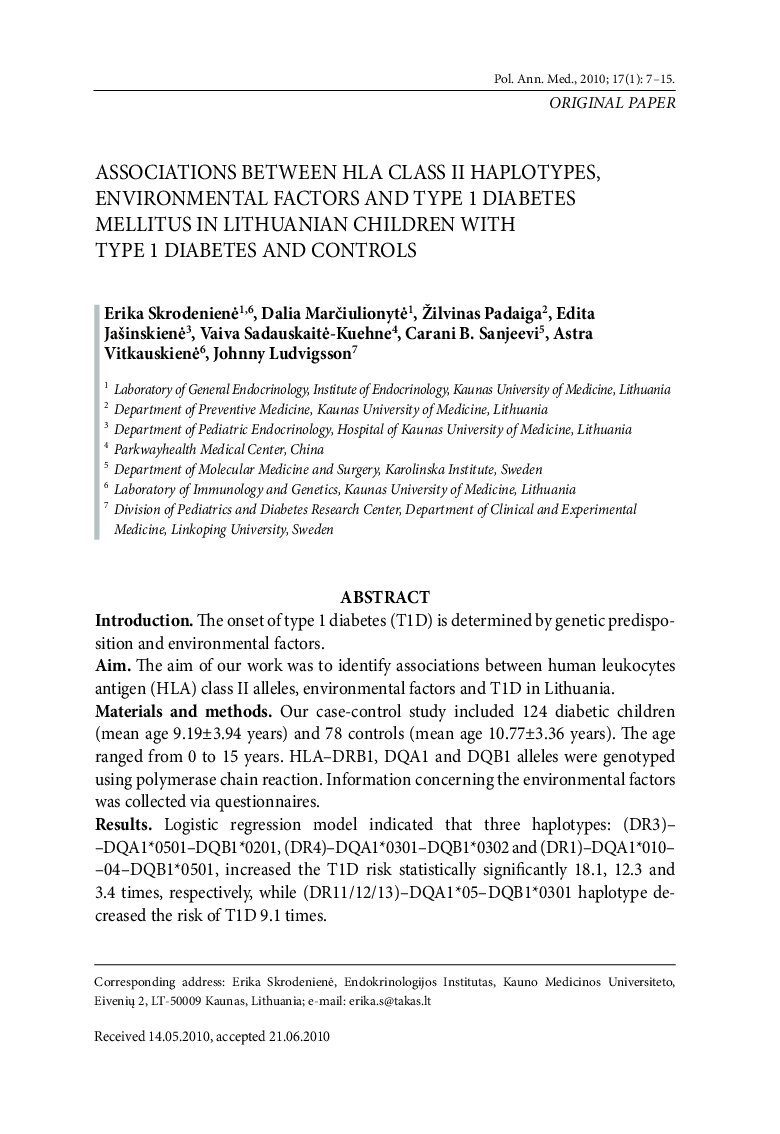| کد مقاله | کد نشریه | سال انتشار | مقاله انگلیسی | نسخه تمام متن |
|---|---|---|---|---|
| 2678954 | 1564460 | 2010 | 9 صفحه PDF | دانلود رایگان |

IntroductionThe onset of type 1 diabetes (T1D) is determined by genetic predisposition and environmental factors.AimThe aim of our work was to identify associations between human leukocytes antigen (HLA) class II alleles, environmental factors and T1D in Lithuania.Materials and methodsOur case-control study included 124 diabetic children (mean age 9.19 ± 3.94 years) and 78 controls (mean age 10.77 ± 3.36 years). The age ranged from 0 to 15 years. HLA–DRB1, DQA1 and DQB1 alleles were genotyped using polymerase chain reaction. Information concerning the environmental factors was collected via questionnaires.ResultsLogistic regression model indicated that three haplotypes: (DR3)– –DQA1*0501–DQB1*0201, (DR4)–DQA1*0301–DQB1*0302 and (DR1)–DQA1*010– –04–DQB1*0501, increased the T1D risk statistically significantly 18.1, 12.3 and 3.4 times, respectively, while (DR11/12/13)–DQA1*05–DQB1*0301 haplotype decreased the risk of T1D 9.1 times.Several different regression models included environmental factors and different sets of risk and protective haplotypes. The results suggest that living in a remote area with lower population density during pregnancy increased the risk of T1D, as well as short breastfeeding, introduction of eggs before 5th month of age and infections during the last 6 months before diagnosis. Smoking during pregnancy as well as rubella and varicella virus infections seemed to decrease the risk of T1D. These associations were revealed while evaluating only environmental factors and when different HLA haplotypes together with environmental factors were included in the regression model.DiscussionThe HLA typing shows that the differences in the incidence of T1D between Lithuania and neighboring countries cannot be explained only by genetics, but lifestyle and/or environmental factors should be considered. A number of studies presented here, have shown conflicting results regarding environmental factors and their associations with T1D.ConclusionsBoth genetic and environmental factors play a major role in diabetes development and protection. However, even quite rapidly ongoing changes of environmental factors and lifestyle in Lithuania have not helped us to reveal any clear picture.
Journal: Polish Annals of Medicine - Volume 17, Issue 1, 2010, Pages 7–15